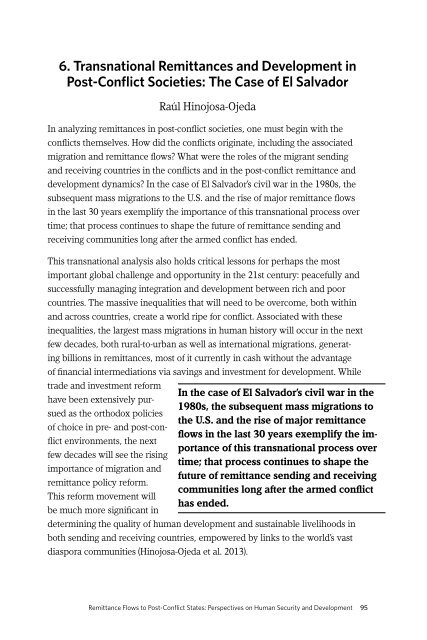Pardee-CFLP-Remittances-TF-Report
Pardee-CFLP-Remittances-TF-Report
Pardee-CFLP-Remittances-TF-Report
Create successful ePaper yourself
Turn your PDF publications into a flip-book with our unique Google optimized e-Paper software.
6. Transnational <strong>Remittances</strong> and Development inPost-Conflict Societies: The Case of El SalvadorRaúl Hinojosa-OjedaIn analyzing remittances in post-conflict societies, one must begin with theconflicts themselves. How did the conflicts originate, including the associatedmigration and remittance flows? What were the roles of the migrant sendingand receiving countries in the conflicts and in the post-conflict remittance anddevelopment dynamics? In the case of El Salvador’s civil war in the 1980s, thesubsequent mass migrations to the U.S. and the rise of major remittance flowsin the last 30 years exemplify the importance of this transnational process overtime; that process continues to shape the future of remittance sending andreceiving communities long after the armed conflict has ended.This transnational analysis also holds critical lessons for perhaps the mostimportant global challenge and opportunity in the 21st century: peacefully andsuccessfully managing integration and development between rich and poorcountries. The massive inequalities that will need to be overcome, both withinand across countries, create a world ripe for conflict. Associated with theseinequalities, the largest mass migrations in human history will occur in the nextfew decades, both rural-to-urban as well as international migrations, generatingbillions in remittances, most of it currently in cash without the advantageof financial intermediations via savings and investment for development. Whiletrade and investment reformhave been extensively pursuedas the orthodox policiesof choice in pre- and post-conflictenvironments, the nextfew decades will see the risingimportance of migration andremittance policy reform.This reform movement willbe much more significant inIn the case of El Salvador’s civil war in the1980s, the subsequent mass migrations tothe U.S. and the rise of major remittanceflows in the last 30 years exemplify the importanceof this transnational process overtime; that process continues to shape thefuture of remittance sending and receivingcommunities long after the armed conflicthas ended.determining the quality of human development and sustainable livelihoods inboth sending and receiving countries, empowered by links to the world’s vastdiaspora communities (Hinojosa-Ojeda et al. 2013).Remittance Flows to Post-Conflict States: Perspectives on Human Security and Development 95


